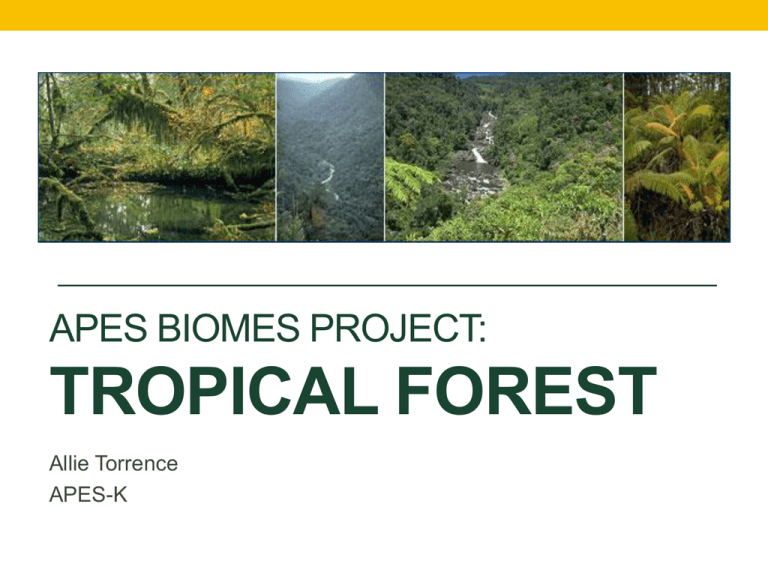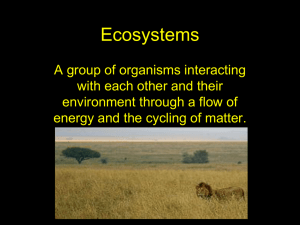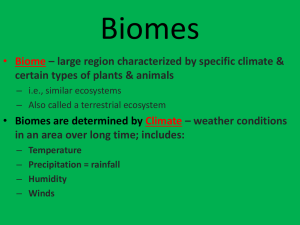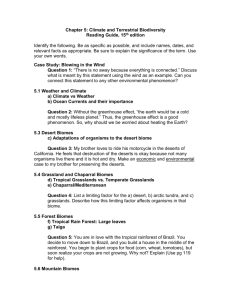APES Biomes Project: Tropical Forest
advertisement

APES BIOMES PROJECT: TROPICAL FOREST Allie Torrence APES-K Common names of this biome? • Evergreen rainforest • Has no dry season. • Seasonal rainforest • Has a short dry period, seasonal changes, and the vegetation appears about the same as evergreen rainforests. • Semi-evergreen forest • Has a longer dry season than the seasonal rainforest. • Moist/dry deciduous forest (monsoon) • Dry season length increases as the amount of precipitation decreases. Found at: http://www.ucmp.berkeley.edu/exhibits/biomes/forests.php#tropical Food web of this biome? Python Vampire Bats Jaguar Iguanas Chimpanzees Macaws Orchids Seeds Fruit Bats Banana Trees Found at: http://www.google.com/ url?sa=t&rct=j&q=&esrc=s&source=web&cd=1&ved=0CCoQFjAA&url=http%3A%2F%2Fhsfs2.ort n.edu%2Fmyschool%2FNGanguly%2FAPES%2520PowerPoint%2FBiomes%2520-%25202nd%2FRainfo rest%2520powerpoint.ppt&ei=Uoj9UsmeE7OmsQTX9IGACQ&usg=AFQjCNG4SCEsS7udwKVrDNnBYQJ DXFbWGg&sig2=dtFh-9Weh7hwdQBGwE4IpQ&bvm=bv.61190604,d.cWc Red-Eyed Tree Frog Parrots Monkeys Bamboo Insects Coconut Trees Where is this biome found in the world? The biome is found “near the equator, within the area bounded by latitudes 23.5 degrees N and 23.5 degrees S.” Found at: http://www.ucmp.berkeley.edu/exhibits/biomes/forests.php#tropical http://www.cotf.edu/ete/modules/k4/biomes/Boverview2.html http://education.kings.edu/dsmith/Lesson%207.html Climate? • Average Temperatures: 20ºC (68.000ºF) - 25ºC (77.000ºF) • Annual rainfall levels: ~200 centimeters (60-160 inches) • Tropical Forest’s have distinct seasonality • Only two seasons: rainy and dry • The length of daylight = 12 hours • Less than 2% of that sunlight ever reaches the ground because of the vast number of tall trees found in the biome. Found at: http://www.ucmp.berkeley.edu/exhibits/biomes/forests.php#tropical http://www.cotf.edu/ete/modules/msese/earthsysflr/rforestP.html Climatograms (1) Tropical Monsoon Climate: Akyab, Myanmar Found at: https://php.radford.edu/~swoodwar/biomes/?page_id=100 Climatograms (2) Found at: https://www.marietta.edu/~biol/biomes/troprain.htm What types of animals and plants are found in this biome? • “Highly diverse: one square kilometer may contain as many as 100 different tree species.” • “Trees are 25-35 m tall, with buttressed (strong/ sturdy) trunks, shallow roots, and large dark green leaves” in order to absorb more sunlight. • “Plants such as orchids, bromeliads, vines (lianas), ferns, mosses, and palms are present in tropical forests.” • “The combination of constant warmth and abundant moisture makes the tropical rainforest a suitable environment for many plants and animals.” Found at: http://www.ucmp.berkeley.edu/exhibits/biomes/forests.php#tropical http://www.cotf.edu/ete/modules/msese/earthsysflr/rforest.html Animal Adaptations • “Learning to eat a particular food eaten by no other animal” due to the wide variety of species and the vast number of organisms. • Finding habitats in trees. This is because tropical forests have many trees whose leaves and branched cover the ground almost entirely. • Example 1: “Toucans have adapted by developing long, large bill. This adaptation allows this bird to reach fruit on branches that are too small to support the bird's weight. The bill also is used to cut the fruit from the tree.” • Example 2: “The sloth uses a behavioral adaptation and camouflage to survive in the rainforest. It moves very, very slowly and spends most of its time hanging upside down from trees. Blue-green algae grows on its fur giving the sloth a greenish color and making it more difficult for predators to spot.” Found at: http://www.cotf.edu/ete/modules/msese/earthsysflr/rforestA.html http://kids.nceas.ucsb.edu/biomes/rainforest.html Plant Adaptations • Tropical forests are very dense but as a result the lower levels receive less sunlight and have less biodiversity. • Plant survival in a tropical rainforest depends on the plant's ability to tolerate shade or to adapt strategies to reach sunlight. • Example 1: “The strangler fig needs sunlight to grow and reproduce. As the strangler fig matures, branches and leaves grow upwards creating a canopy that blocks sunlight from the host tree. Additional roots are sent out and wrap around the host tree, forming a massive network of roots that strangle and eventually kill the host.” Found at: http://www.cotf.edu/ete/modules/msese/earthsysflr/rforestP.html What are the human impacts on this biome? • Deforestation: • “More than one half of tropical forests have already been destroyed.” • “Each year, some 140,000 sq km of rainforests are destroyed” by logging companies who use the tree lumber to make profit or the forest area is cleared for farming purposes. • “Many endangered tropical forests are located in Africa. The forests there are in severe danger because human populations are doubling every 20 years.” • With the large population then there is a higher demand for the biome’s resources. • leads to decreased oxygen levels around the world because tropical forests produce much of the oxygen that humans use. Found at: http://wwf.panda.org/about_our_earth/ecoregions/about/habitat_types/habitats/tropical_forests/ http://www.ucmp.berkeley.edu/exhibits/biomes/forests.php Other fun and interesting facts! • “A hectare of Malaysian rainforest may contain 180 kinds of trees. • “A temperate forest hectare might have just 10 species of trees.” • “Over 15 million species of plants and animals live within this biome around the world.” Found at: http://wwf.panda.org/about_our_earth/ecoregions/about/habitat_types/habitats/tropical_forests/ http://www.cotf.edu/ete/modules/msese/earthsysflr/rforest.html Works Cited: (1) All About Toucans – The Birds With Long, Brightly Colored Bill. (2014). Retrieved February 13, 2014, from Easy Science for Kids website: http://easyscienceforkids.com/all-about-toucans/ Baker, W., & Livesay, L. (n.d.). Tropical Rain Forest [PowerPoint slides]. Retrieved February 13, 2014, from http://www.google.com/url?sa=t&rct=j&q=&esrc=s&source=web&cd=1&ved=0CCoQFjAA&url=htt p%3A%2F%2Fhsfs2.ortn.edu%2Fmyschool%2FNGanguly%2FAPES%2520PowerPoint%2FBiomes%2520%25202nd%2FRainforest%2520powerpoint.ppt&ei=Uoj9UsmeE7OmsQTX9IGACQ&usg=AFQjCNG4SCEsS7 udwKVrDNnBYQJDXFbWGg&sig2=dtFh-9Weh7hwdQBGwE4IpQ&bvm=bv.61190604,d.cWc ETE Team (Ed.). (2004). Topic Overview: Forests. Retrieved February 12, 2014, from K4 Modules: Biomes website: http://www.cotf.edu/ete/modules/k4/biomes/Boverview2.html Gaby Gollub, FONZ. (n.d.). Strangler Fig [Image]. Retrieved from http://nationalzoo.si.edu/animals/photogallery/amazonia/14.cfm Onishu, N. (2000, January 5). Tropical Rain Forest. Retrieved February 12, 2014, from Lesson 7 : Major Biomes website: http://education.kings.edu/dsmith/Lesson%207.html Rainforest. (2004). Retrieved February 13, 2014, from Kids Do Ecology: World Biomes website: http://kids.nceas.ucsb.edu/biomes/rainforest.html strangler fig. (n.d.). In Encyclopædia Britannica (Ed.), Encyclopædia Britannica. Retrieved February 13, 2014, from http://www.britannica.com/EBchecked/topic/568081/strangler-fig Toft, R. (2014). Two-Toed Sloth [Photograph]. Retrieved from http://animals.nationalgeographic.com/animals/mammals/two-toed-sloth/ Works Cited: (2) Tropical Forests. (n.d.). Retrieved from WWF Global website: http://wwf.panda.org/about_our_earth/ecoregions/about/habitat_types/habitats/tropical_forests/ The Tropical Rain Forest. (n.d.). Retrieved February 10, 2014, from https://www.marietta.edu/~biol/biomes/troprain.htm University of California Museum of Paleontology. (2006). Tropical forest. Retrieved February 10, 2014, from The Forest Biome website: http://www.ucmp.berkeley.edu/exhibits/biomes/forests.php#tropical Wheeling Jesuit University. (2005, April 28). Tropical Rainforest. Retrieved February 10, 2014, from Earth Floor: Biomes website: http://www.cotf.edu/ete/modules/msese/earthsysflr/rforest.html Woodward, S. L., Dr. (2012). Tropical Rainforest. Retrieved February 12, 2014, from Biomes of the World website: https://php.radford.edu/~swoodwar/biomes/?page_id=100








